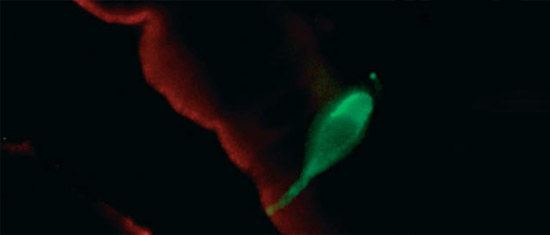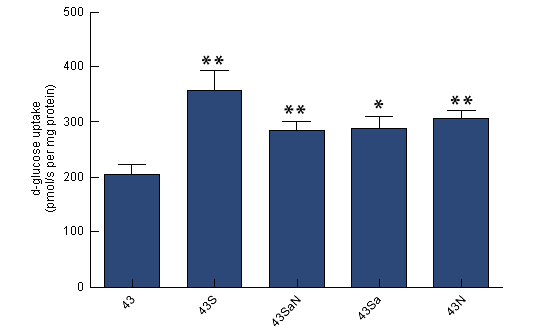Simple carbohydrates, like sugars, seem to stimulate sweet taste in pigs enhancing voluntary intake. The use of sweeteners in pig diets is a common practice particularly in young animals. Among other sweeteners, non-carbohydrate high intensity sweeteners (HIS) such as saccharin (SAC), thaumatin (THA), stevioside and neohespiridine (NHDC) are widely used. Kennedy and Baldwin (1972) studied preferences to sucrose, glucose and SAC establishing thresholds that ranged from 0.005 to 0.01M for sucrose and from 0.01 to 0.03M for glucose. For both substances pigs showed consistent preferences (higher than 90%). In contrast, results for SAC were more variable and the threshold for preference did not improve sucrose and was established to be between 0.005 and 0.1M. Furthermore, preference values to SAC solutions were never higher than 90% and concentrations above 0.1 M resulted in rejection.
Danilova et al. (1999) performed electrophysiological studies in pig tongue reporting high neuronal responses to carbohydrate sweeteners such as fructose, sucrose or lactose among other mono and oligosaccharides. In preference trials sucrose showed the highest intensity of all the carbohydrates tested and their responses were very similar to sugar sensory tests in humans (Glasser et al., 2000). On the other hand pigs did not respond to human equivalent doses of HIS such as NHDC, THA, or SAC (Table 1) and the HIS combinations widely used in pig feeding such as SAC with NHDC and/or THA did not give any better response either.
Table 1. Sweetener potencies relative to sucrose (on a molar basis) in humans and pigs (adapted from Glasser et al., 2000).
| Potency relative to sucrose | |||
| Humans | Pigs(1) | ||
| Carbohydrates | Sucrose | 1,00 | 1,00 |
| D-fructose | 0,50 | 0,50 | |
| Lactose |
0,33 |
0,15 | |
| D/l-glucose |
0,25 |
0,13 | |
| Non-Carbohydrates | Aspartame | 155 |
< 1,00(2) |
| Cyclamate (Na+ salt) | 17,6 |
< 0,15(2) | |
| Neohesperidin (dihydrocalcone) | 3.600 |
< 151(2) | |
| Thaumatin |
2.000 |
< 1.622(2) | |
| Saccharin | 215 |
3,34 | |
(2) Equivalent to the lowest dose tested that gave no response. The exact potency was not determined.
However, in recent years the field of sweet taste has experienced a sudden twist due to the presence of taste receptors (TR) not only in clusters in the oral cavity (taste buds) but also in non-taste tissues particularly in the mucosa of the GIT. It is believed that the TR expression in the GIT mucosa is related to post-ingestive events such as the recognition of nutrients in the lumen (i.e. glucose) and the facilitation of digestion and absorption (Dyer et al. 2005, Mace et al. 2009). Furthermore, TR in enteroendocrine cells may participate in the complex events leading to control of feed intake. For example, dietary carbohydrates and some HIS may increase glucose absorption by stimulating the T1R2 receptor in the gut mucosa which, in turn, triggers active glucose transport through the SGLT1. Porcine sweet TRs have been involved in up-regulating SGLT1 and glucose uptake after stimulation with sucrose, SAC or NHDC in piglet intestinal mucosa (Figures 1 and 2 –Moran et al. 2010-). If these findings would be confirmed we could speculate in HIS to be involved in improving glucose uptake but also to initiate an orexigenic response through GLP1, thus potentially enhancing feed intake in piglets through post-ingestive events.

Fig 1. Expression of Na++/glucose co-transporter 1 (SGLT1) in red and T1R2 in green along the crypt–villus axis of swine small intestine. This Figure has been reproduced with permission of the British Journal of Nutrition and corresponding author of the original publication Dr. S. Shirazi-Beechey. Original reference: Moran AW, Al-Rammahi MA, Arora DK, Batchelor DJ, Coulter EA, Daly K, Ionescu C, Bravo D y Shirazi-Beechey. Expression of Na+/glucose co-transporter 1 (SGLT1) is enhanced by supplementation of the diet of weaning piglets with artificial sweeteners. 2010 Sep. Br J Nutr. Cambridge University Press.

Fig 2. Initial rates of Na+-dependent d-glucose uptake into brush-border membrane vesicles measured in swine mid-small intestine in response to feed supplementation with the artificial sweeteners, Sucram (43S), saccharin (43Sa), Neohesperidin dihydrochalcone (NHDC, 43N) or saccharin and NHDC (43SaN). Mean values were significantly different: *P < 0·05, **P < 0·01, ***P < 0·001. This Figure has been reproduced with permission of the British Journal of Nutrition and corresponding author of the original publication Dr. S. Shirazi-Beechey. Original reference: Moran et al. British Journal of Nutrition (2010), 104: 637-646, Cambridge University Press.
The relevance of these findings stands in that human HIS do not seem to be effective in increasing feed intake in piglets, however, they may play an important role in improving the efficiency of carbohydrate digestion/absorption in young animals. The task of finding true appetite/taste enhancers remains then unfinished but the use of SAC, THA and/or NHDC seems justified in the light of their post-ingestion effects.





